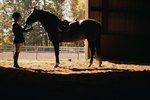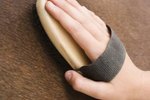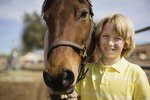
If your draft horse were human, he’d be the big, burly farmer working from dawn to dusk and beyond. Historically, draft horses were the machines that kept agriculture, industry and armies functioning globally. Progress has put the draft horse population to pasture, but today many people train them to pull wagons and carts and ride them as pleasure mounts. You won't train a draft horse much differently than other breeds, but you'll emphasize certain instructions. Their innate work ethic renders draft horses willing even if they don’t exude tremendous energy.
Draft Breeds
The only draft breed that originated in the United States is the American cream draft; most came from Europe. Common breeds include Clydesdale, Percheron, Belgian and Shire. Some draft breeds tip the scales at more than 2,000 pounds; others are more compact. The Schwarzwalder Fuchs typically grows to 15 hands or about 60 inches at the withers. The Percheron can reach 19 hands or 76 inches.
Basic Handling
The draft horse is strong. Emphasize respect in your training or he can easily hurt you. Work on haltering and handling basics, emphasizing the importance of his not invading your personal space. Teach him to give to pressure, to reduce the odds he’ll pull back while tied. Ask him to lower his head by tugging down on the lead rope. As soon as he complies, release the pressure. Repeat this with other body parts, pushing on his shoulders and hindquarters until he moves away from you. Always release pressure immediately when he responds. Teach him to back away from you by standing 3 feet in front of him, wiggling the lead rope until he takes a step back. As soon as he takes one small step, stop wiggling the rope.
Move Forward
Your horse needs to go when you tell him to. This is typically more challenging with draft breeds; when they do comply it’s typically with very little propulsion. According to Danielle Meyers, owner and trainer of Meyers Sport Horse Services in Austin, Texas, you have to instill a forward-thinking mindset. “They have to be thinking ‘go’ all the time ... Once you get that forward obedience, they are very willing.” Emphasize this while lunging and riding, asking for a faster pace than you would with another breed. When you first ask him to canter, it may feel unbalanced, Meyers says. “This takes a long time to correct and usually requires a professional trainer."
New Experiences
As prey animals, horses prefer flight over fight. A draft horse is different. With more strength than speed, his odds of a successful fight are better than those of running. He may startle and bolt, he’s not likely to go far. You must train him to listen to you when he’s frightened. Incorporate “sacking out” into ground training by exposing him to strange objects. When he reacts, give him a calming verbal cue. With most breeds, a good cue is to ask the horse to lower his head, but with the draft horse, you need to keep his feet moving, since the draft instinct is to stand still. Ask him to move his hips or shoulders over. When he listens to you, reward by releasing pressure. Do this until he no longer reacts to the frightening object.
References
- Danielle Meyers, Trainer, Meyers Sport Horse Services, Austin, Texas
- Horse Show Central: Draft Horses -- Draft Breeds & Info
- Washington State University Handbook: Draft Horse Handbook
- Equusite: Get Some Respect!
- Equisearch: Sacking Out the Problem Horse
- Cornell University Cooperative Extension -- CCE Equine: Horse Fight vs. Flight Instinct
Resources
Photo Credits
-
Thinkstock/Comstock/Getty Images
Writer Bio
Based in Central Texas, Karen S. Johnson is a marketing professional with more than 30 years' experience and specializes in business and equestrian topics. Her articles have appeared in several trade and business publications such as the Houston Chronicle. Johnson also co-authored a series of communications publications for the U.S. Agency for International Development. She holds a Bachelor of Science in speech from UT-Austin.




